Mike Tyson Takes One Last Swing at Immortality
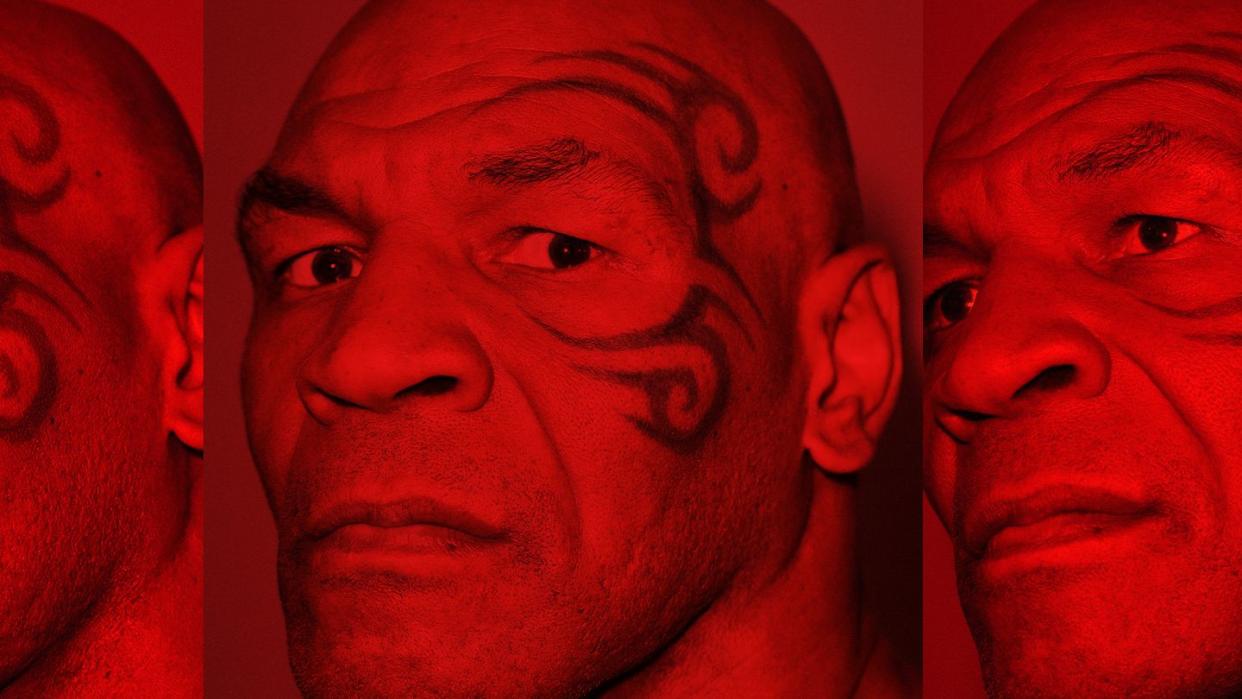
Mike Tyson steps through the black ropes and lies down on his back in the middle of the boxing ring. He looks up at the ceiling of the warehouse in the Las Vegas suburbs and closes his eyes. The makeshift gym is so silent and sterile that all you can hear is his breathing and the hum of the air-conditioning.
In a few weeks, Tyson will turn fifty-eight. He’s back in training for his first officially sanctioned boxing match in nearly twenty years—a much-hyped matchup with the influencer-turned-pugilist Jake Paul that is set to be held in a football stadium filled with fans and streamed live to a potentially massive audience online.
But right now it’s time to get to work. The warehouse where Tyson has set up his camp is next to the headquarters of the Las Vegas Raiders, and team owner Mark Davis is letting Tyson use the space, which is minutes away from Tyson’s house. Perhaps not coincidentally, the color scheme is very Raiders. A tall black curtain separates the training area, with its black-and-silver weight equipment, from the rest of the more-than-15,000-square-foot structure and contrasts with the white walls and ceilings. On one wall and hanging above the ring are black-and-white signs that read mike tyson boxing club. Behind a rack of dumbbells, there’s a large black-and-white poster board with a photo of Tyson—hands wrapped, towel over his head—and a quote from the former heavyweight champ himself: “Discipline is doing what you hate to do, but doing it like you love it.”
His trainer, Rafael Cordeiro, begins stretching out Tyson’s tree-trunk legs. Then he starts working on his back. Tyson, who now battles occasional sciatica, grimaces softly as he leans forward.
Now loose, he gets up and walks slowly to the slip bag. He looks at himself in the mirror—a sweaty, jacked, older version of the “Baddest Man on the Planet,” who once rode on the end of a lightning bolt to the top of the world before crashing back down to earth—and places the bag against his forehead. After a moment, he steps back from the bag, bobbing and weaving methodically at first to help hone his head-movement defense. The exercise quickens, with a bucket’s worth of sweat flying from the wrinkles on his head and the white hairs on his face, splattering against the mirror and the bag.
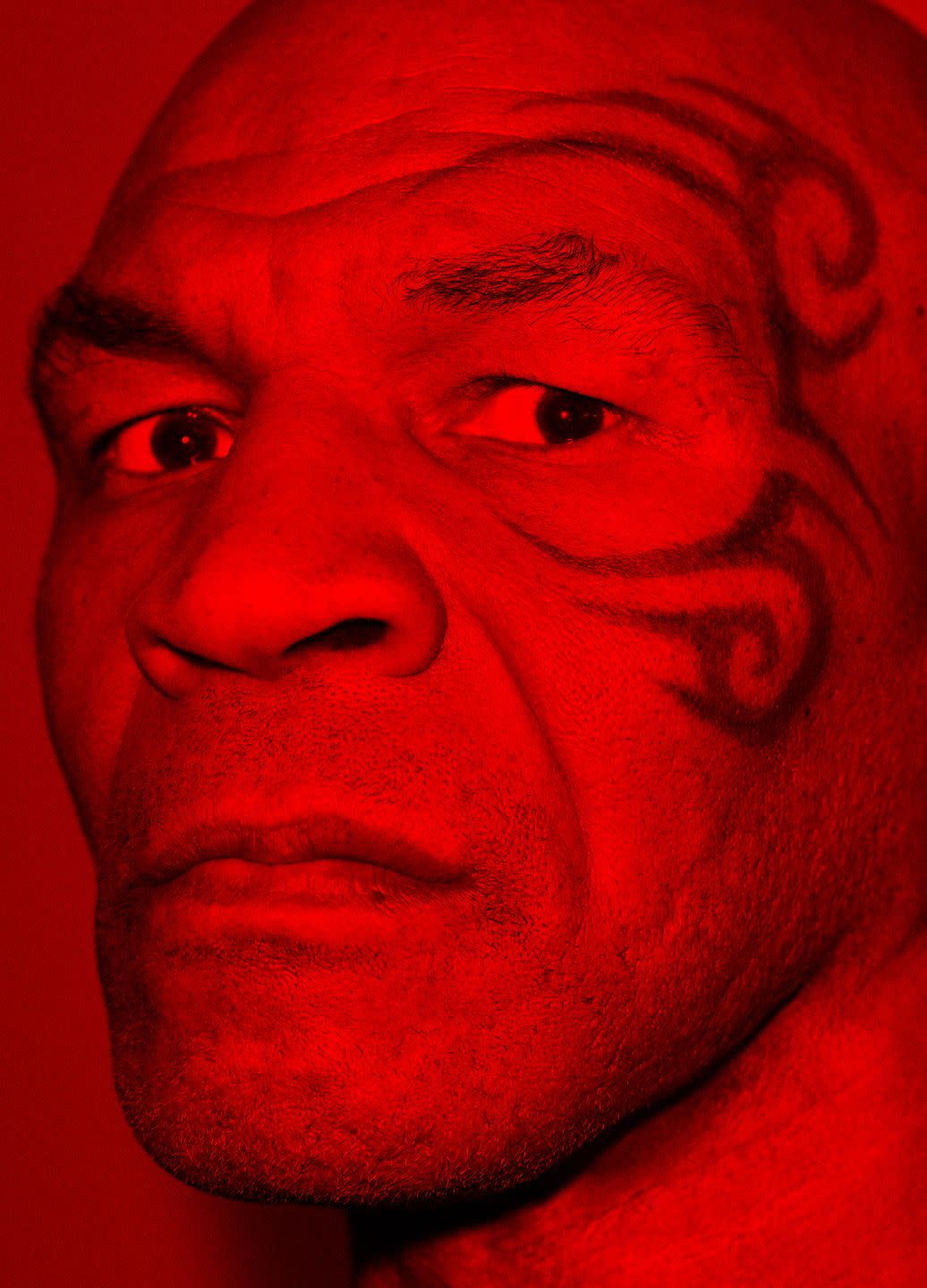
“I want to hit the mitts,” he says.
When Tyson gets back in the ring to train with Cordeiro, who’s covered up to his neck in pads, what follows is a blizzard of left-right-left-right—over and over again. The power of Tyson’s punches reverberates throughout the warehouse. In the moment, whether he can still punch with bad intentions after all these years doesn’t feel like the right question. It’s more like, Did you hear that? The sound of silence has been replaced by the sound of violence.
Tyson wonders aloud if Paul, his opponent, who is thirty-one years his junior, has any chance to touch him.
“Can I be honest?” he asks his team.
Please, Iron Mike. Be honest with us.
“I don’t think he can hurt me.”
He’s feeling himself. He spits outside the ring before turning to Billy White, a coach who has known Tyson since he was a teenager training with the legendary Cus D’Amato, for confirmation: “Coach, I don’t think he can hurt me!”
White smiles and nods. So does Tyson’s wife, Lakiha (known as Kiki), who is filming him on her iPhone from ringside. She also offers a reminder.
“Baby,” Kiki yells, “drink your electrolytes more than usual!”
Tyson obliges. He knows that Kiki knows what’s good for him. He takes a swig from his three-liter jug and gets back to work.
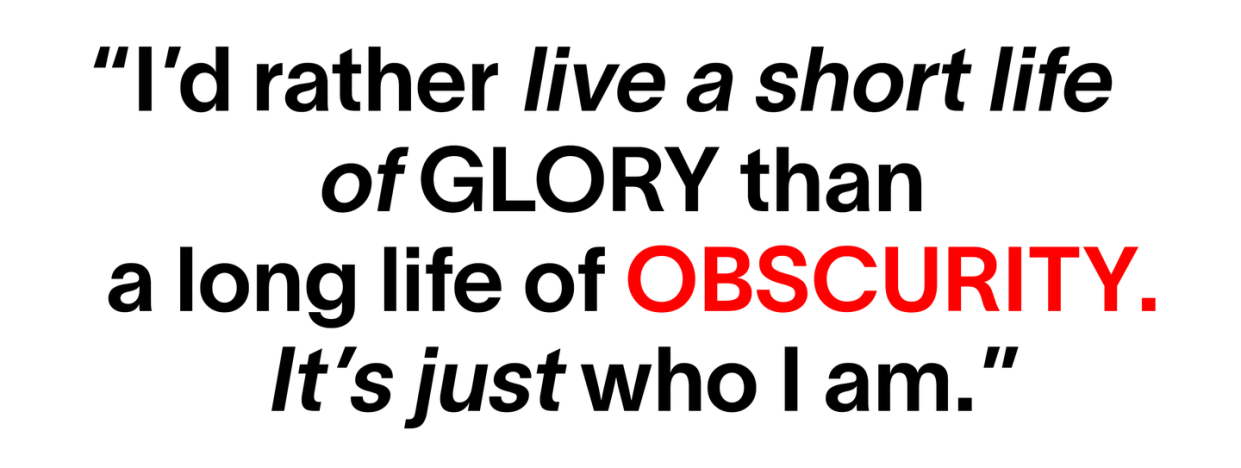
In the almost two decades since his last official fight (he fought an exhibition match against Roy Jones Jr. in 2020), Tyson has battled through deep financial despair, grappled with legal issues, struggled with a cocaine addiction, and suffered the tragic loss of his four-year-old daughter, Exodus, in 2009. But in that same period, Tyson has also become one of the more interesting and unexpected second-chance stories in recent American history—finding family, stability, and cultural acceptance in the process.
Today, he is a financially healthy family man and husband of fifteen years, a New York Times best-selling author who performed his own autobiography as a one-man Broadway show, the owner of one of the nation’s most successful celebrity cannabis brands, and a podcaster who gets really deep—and really high—with his guests. This late-life renaissance has led Tyson to take on an opponent he knows he can’t knock out but wishes to take the distance: Father Time.
That Tyson’s return to the ring comes against Paul makes the event an instant spectacle. The polarizing twenty-seven-year-old YouTuber has posted a 9–1 record since he broke into professional boxing. And along the way, Paul has become the face of the sport’s push to reach new fans by winning over celebrities, influencers, and disrupters. Older boxing fans will be watching to see if the old champ still has what it takes to smack down a mouthy newcomer. Paul’s followers want to see him knock off a legend. The fight will be held at AT&T Stadium in Arlington, Texas, home of the Dallas Cowboys, and streamed on Netflix for the platform’s 270 million subscribers in more than 190 countries.
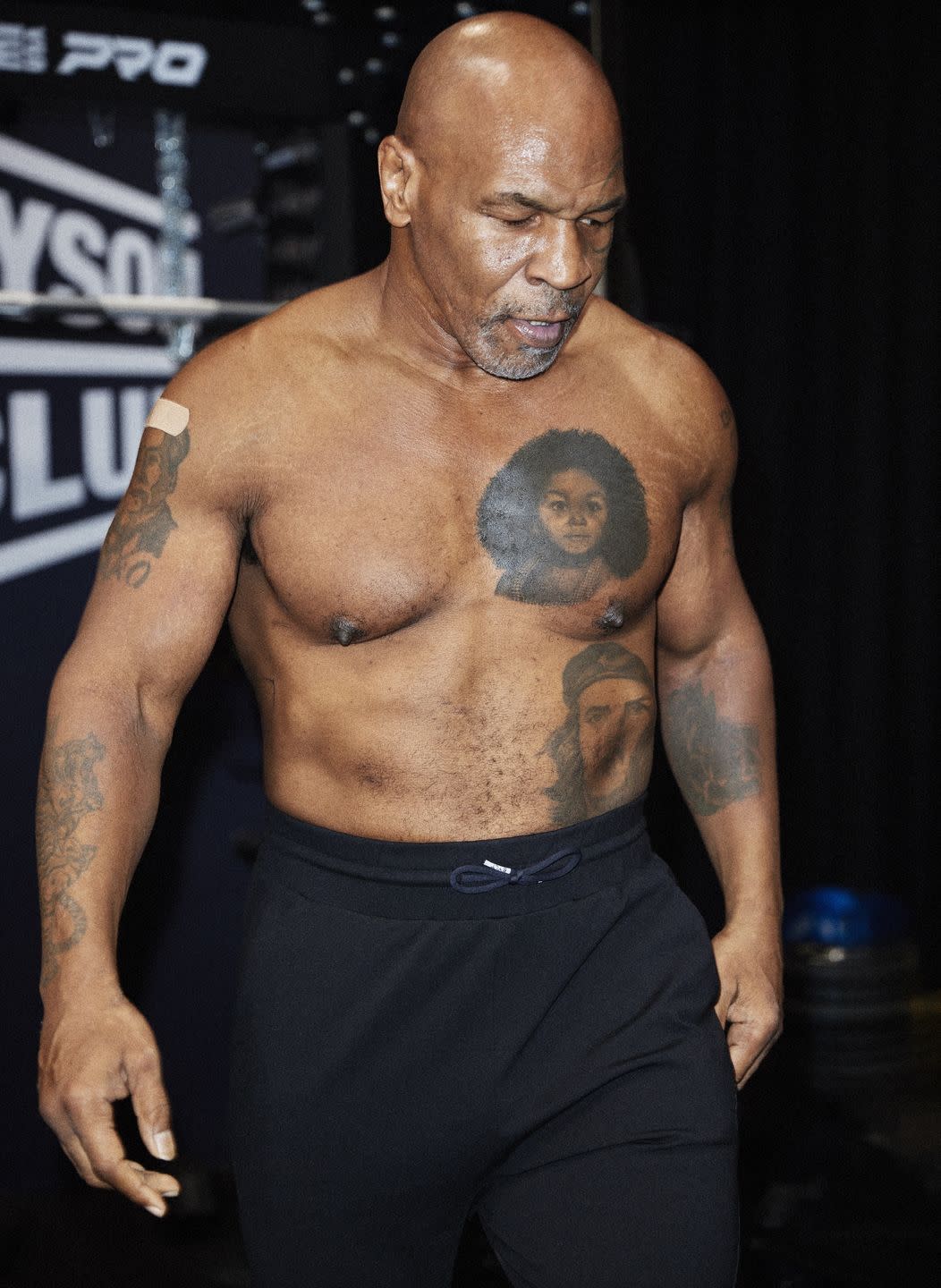
Netflix has promoted it as potentially the most watched combat-sports event in history—making Tyson the box-office bridge between boxing’s former glory and its brave new reality in the world of social media.
“I don’t think this was meant to be done by any man but me,” Tyson tells me, his eyes lighting up with passion. “I love it.”
The world will have to wait a little longer than originally planned to see Tyson make that history, however. In late May, a few days after I visited him in Vegas, Tyson was on a flight from Miami to Los Angeles when he experienced a serious ulcer flare-up requiring medical attention. His doctors instructed him to dial back his training for a few weeks to recover. That meant the fight, which had been set for July 20, had to be rescheduled for November 15. And the boxing officials in Texas say they will be watching Tyson closely to make sure that his stomach problems have subsided before they let him step into the ring. The bout is scheduled for eight rounds of two minutes each, rather than the usual three minutes, with bigger-than-usual fourteen-ounce gloves. (Paul announced in late June that he would now use the July 20 date to take on Mike Perry, a former UFC and Bareknuckle Fighting Championship competitor, in an eight-round cruiserweight boxing match in Tampa while he waits for Tyson.)
Even before the medical incident, plenty of pundits were questioning the wisdom of allowing a nearly sixty-year-old man to take such a risk. His medical setback may only add intrigue for many fight fans. The curiosity in the buildup to the fight has been mostly divided into three questions. Will Tyson kick Paul’s ass? Will Tyson embarrass himself and lose? And maybe the most important: Why is Tyson doing this at his age?
“He’s always going to be the man in a lot of our eyes,” says Ric Flair, the professional-wrestling legend and a friend of Tyson’s, who founded his own cannabis brand, Ric Flair Drip. “But I think he wants to be the man again.”
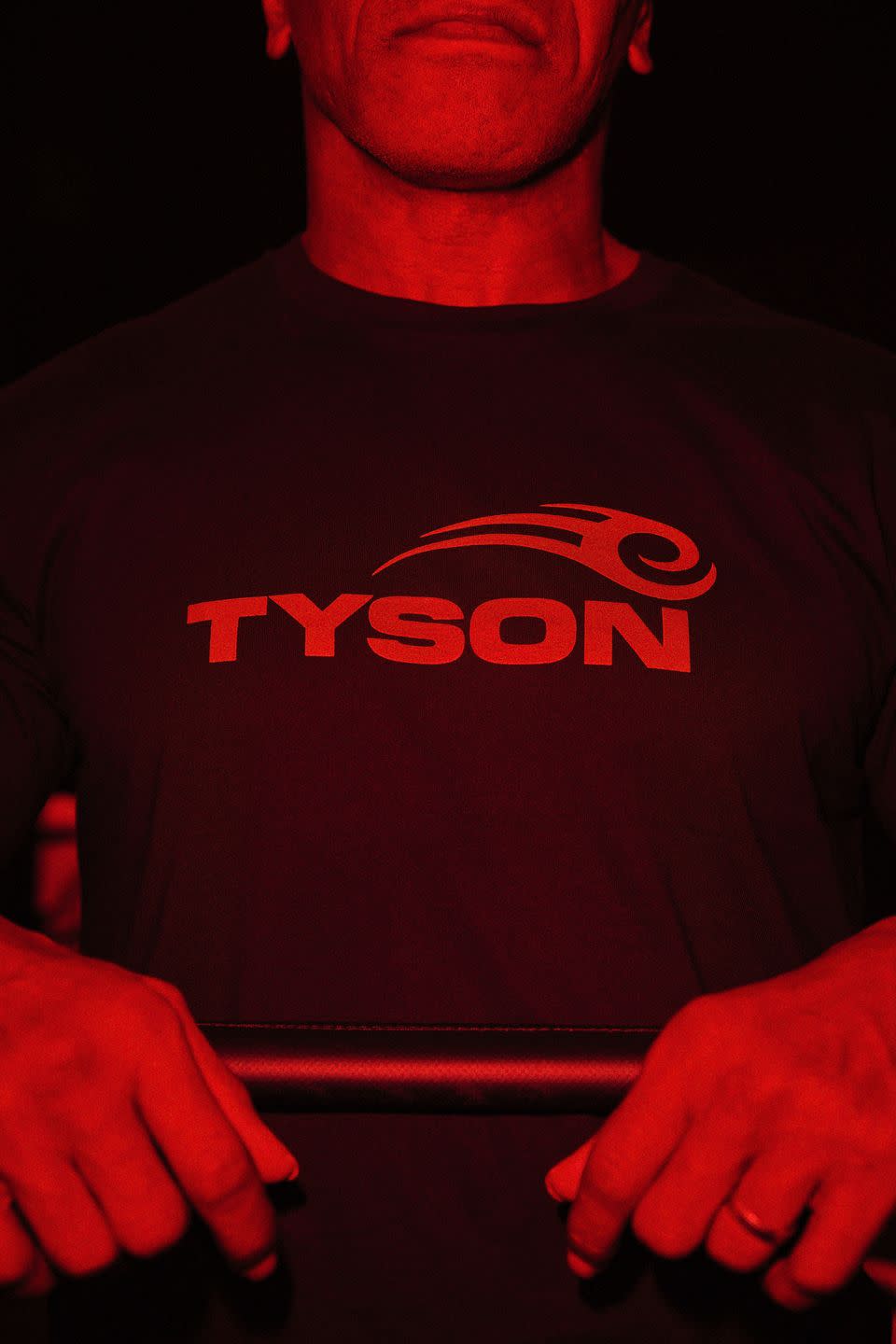
The Reverend Al Sharpton, who supported Tyson back in the 1990s when he was released from a three-year prison stint—after a conviction for a rape charge for which Tyson still maintains his innocence—describes the chance of seeing his friend fight one more time as “almost like going to see a rare piece of art in a museum.”
“Mike Tyson is one of America’s last originals,” says Sharpton. “How do you tell somebody who always did the impossible that they have to conform to the possible?”
Tyson knows that people are describing his decision to take the fight as the aging boxer’s version of a midlife crisis. He gets sensitive when reporters ask if he’s still got it, or when skeptics suggest the bout is a gimmick event that isn’t real. He simmers down a little when he reminds himself that most of those who question him have never stepped into the ring themselves. Still, his inability to say no to a fight—a mindset D’Amato instilled in him that has stayed with the kid from Brooklyn—has even surprised Kiki, he admits.
“My wife keeps saying, ‘You don’t have to do this. You don’t have to do this.’ And I’m like, ‘No, I do have to do this,’ ” he tells me, stressing that the millions he’s reportedly making from the fight “will not change my life financially in any way.”
So why is Tyson trying to chase and summon a version of his younger self—the ruthless ring destroyer who became the youngest world heavyweight champion in boxing history at age twenty? It’s because he’s an addict. Always has been, always will be. But it’s no longer about sex, cocaine, or anger. These days, Tyson says, he is addicted to cannabis and to his wife telling him he’s a great husband.
Oh, and one more old addiction: glory. It’s the jones that hasn’t left him.
“I’m a glory junkie. I love people thinking about me all day,” he says. “I’d rather live a short life of glory than a long life of obscurity. It’s just who I am.
“This is all I started fighting for—to get all this fucking status. I’m going to be chasing it for the rest of my life. I know that. I’m never going to get what I want, because I’m one of those gluttons for pain. I can never get enough.”
A boy comes to me with a spark of interest, I feed the spark, and it becomes a flame. I feed the flame, and it becomes a fire. I feed the fire, and it becomes a roaring blaze. —inscription on Cus D’Amato’s headstone
Don’t ask Tyson if he’s an icon, or what he thinks his legacy looks like. Those two words make him wildly uncomfortable. “What is an icon?” he asks after a doctor’s appointment in late May. “I’m still going to die; I’m still going to starve if I don’t eat. Suppose I go on hard times and become a bum on the street. Am I still an icon? What is my legacy? Nothing but an ego. Who cares about my legacy? My legacy can’t buy me a hot dog. Legacy is going to get me nothing.”
And don’t tell him he’s the greatest boxer ever. That irritates him, too, even if he usually hides it.
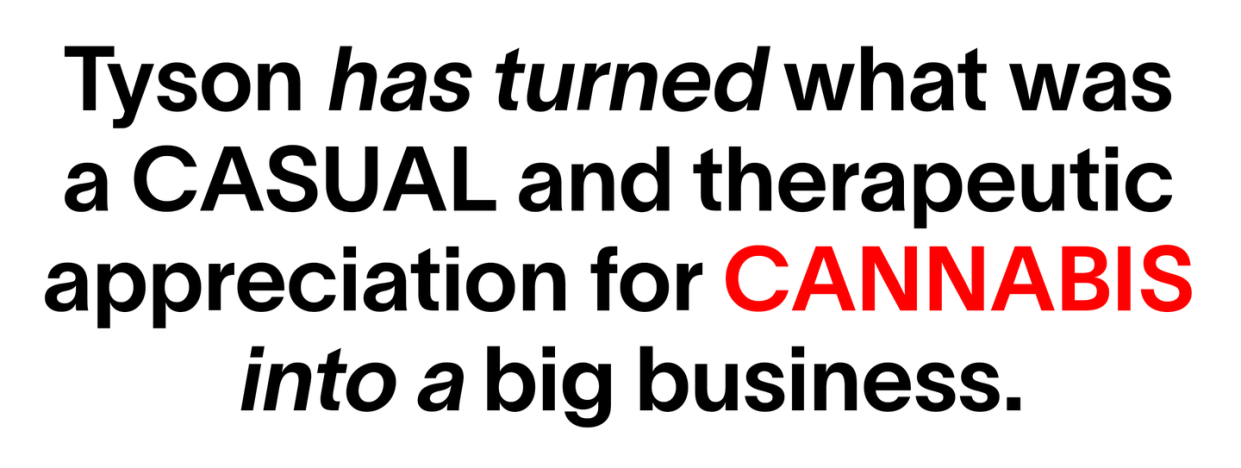
“Let me tell you this,” he begins. “Fans say I’m the greatest fighter who ever lived. Anybody that is a great fighter who gets told you’re the greatest ever, you say, ‘Thank you,’ but that’s bullshit. Deep in my heart, I know these guys don’t know what a great fighter is.”
A week before we spoke in Vegas, Tyson had flown to New York for the first press conference to promote the fight. He returned to the Apollo Theater in Harlem, about four blocks from the old Dapper Dan’s boutique shop, where Tyson punched out the boxer Mitch Green in an impromptu early-morning scuffle in August 1988 after Green confronted him, saying that Don King owed him money. (Green left with his eye shut and stitches on his nose.)
The past is always present for Tyson. Video packages for the Paul fight are covered with clips of knockouts from decades ago, back when Tyson had hair and didn’t have the dramatic tattoo of a New Zealand Māori warrior on the left side of his face. When the press event begins, Tyson takes on a different role in this Netflix-and-social-media hybrid of a press conference: He’s the adult in the room. After a young boy who models himself as a mini Paul asks a couple curse-word-laden, inappropriate questions in his attempt to go viral, Tyson asks what the rest of the room is thinking. “Where’s your mother at?”
The Apollo crowd laughs, as does Tyson. He admits he can’t believe this is a real press conference for a real fight. What is this he’s gotten himself into?
“Forgive me, I’m an old dude,” he says. “This is new.”
He can barely keep a straight face for four seconds as he faces off with Paul, eventually giggling with his opponent.
Videos of Tyson knockouts are nostalgia porn. Go on YouTube and you can get lost in the compilations of brutal hooks, vicious uppercuts, and slow-motion shots of his opponents’ unconscious bodies crashing to the mat. It’s what helped build the mystique around the fighter when he was first starting out, with local newscasts running video packages of a young Tyson demolishing everything in his sight.
“When you were watching him knocking out opponents and them flying through the air, it didn’t look mythical—it looked real,” says Jim Lampley, the former HBO boxing commentator who is now a professor at the University of North Carolina at Chapel Hill and a contributor to PPV.com. “This kid was like nothing we had ever seen before. Mike became a cultural phenomenon from the get-go.”
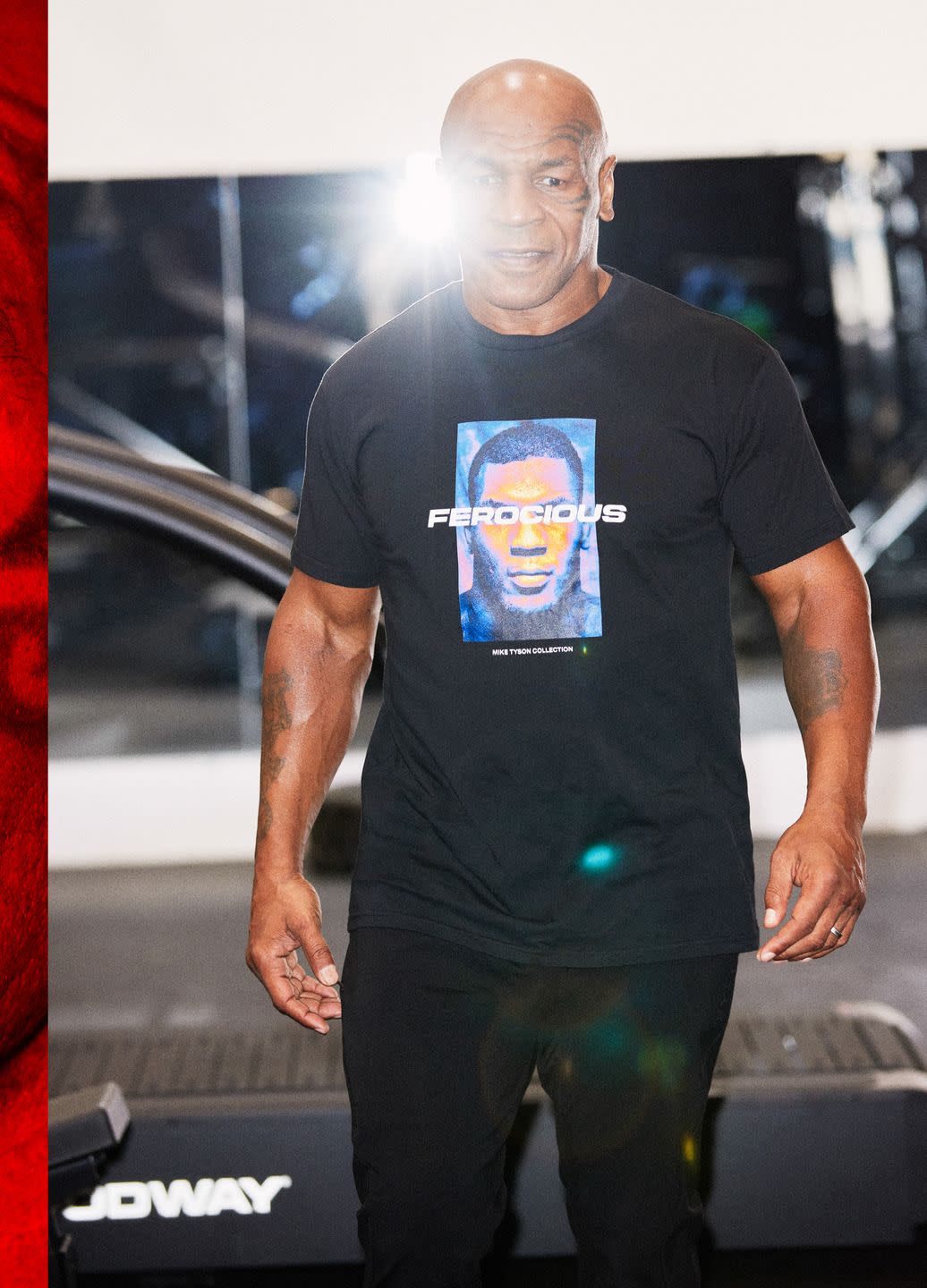
It’s difficult to think of Tyson as being old. For millions, he is frozen in time as the twenty-year-old who conquered the world and could not be stopped. That’s not the guy who is training to fight Paul. Sitting in one of the black-leather recliners next to the ring in the training facility, Cordeiro says he understands the care needed to control his fighter’s fire. Cordeiro, who began training Tyson for the Jones exhibition fight out of Tyson’s garage at the start of the pandemic four years ago, is using the same message passed down by D’Amato all those years ago. Be the fire, control the fire, and turn the flame up to high when you absolutely need it.
“You have to keep the fire on blue. When the fire is on blue, you have control of the fire,” Cordeiro says, comparing Tyson to a stove. “Mike has control of the fire. But when you step inside the ring, he knows how to go high as fast as possible.
“You still don’t mess with Mike.”
Billy White, who has known Tyson for more than forty years, since they were both with D’Amato, remembers picking up the phone in a church parking lot and hearing his friend’s plans and his message: I need you. White didn’t hesitate and is helping his friend train three times a day, believing that only Tyson could pull this off, no matter his age.
“He’s the ultimate warrior,” the coach says outside the warehouse near Las Vegas. “The gods have called him out. How great that they called on him. Who else were they going to call?”
It’s not a problem for Tyson that many see him as forever young and hold on to this image of him. Yet he knows what kind of person he was back then—ruthless, dangerous, angry. And now as a father and role model for his children, he hates what he was.
“He’s never going to leave me,” Tyson says of his younger self. “But you have to realize I’m not that person anymore. That’s just the reality. I’m not that person. I will never be that person again. I don’t like that person.”
Tyson wouldn’t be fighting Paul, he says, if there wasn’t a chance he could fail or be humiliated. As he talks, Tyson leans in and reflects on what he’s learned through failure. He speaks softly but never breaks eye contact.
“I learned about life from my losses. I’ve learned that as I get older and I lose my friends, my children, my teeth, my hair—and eventually, I’m going to lose my life—life is all about loss,” he says. “We’re going to be old one day. We’re going to lose our teeth, lose our eyesight, lose our hair, lose our dick, lose everything we thought made us who we were. We’re going to lose our identity. In the end, we’ll be grateful if someone has a picture of us on the family wall, if they even put up a picture of us.”
Failure is an advanced form of learning for Tyson, but he’s hoping to avoid another lesson in loss in north Texas. Tyson does have respect for Paul, who went from performing skits on Vine in 2013 to fighting in his second professional-boxing match on the card of Tyson’s exhibition fight with Jones in 2020. He still calls Paul a friend, even as the influencer has vowed to “knock this old man the fuck out.” But Tyson revels in talking shit and trolling him. Like the time he called Paul “fat and funky” in assessing his opponent’s shirtless physique. Or when he said that a video of Paul dancing when he was sixteen strangely gave Tyson an erection. Two days after he suffered the ulcer flare-up, Tyson couldn’t help but jab at Paul on X: “Now feeling 100% even though I don’t need to be to beat Jake Paul.”
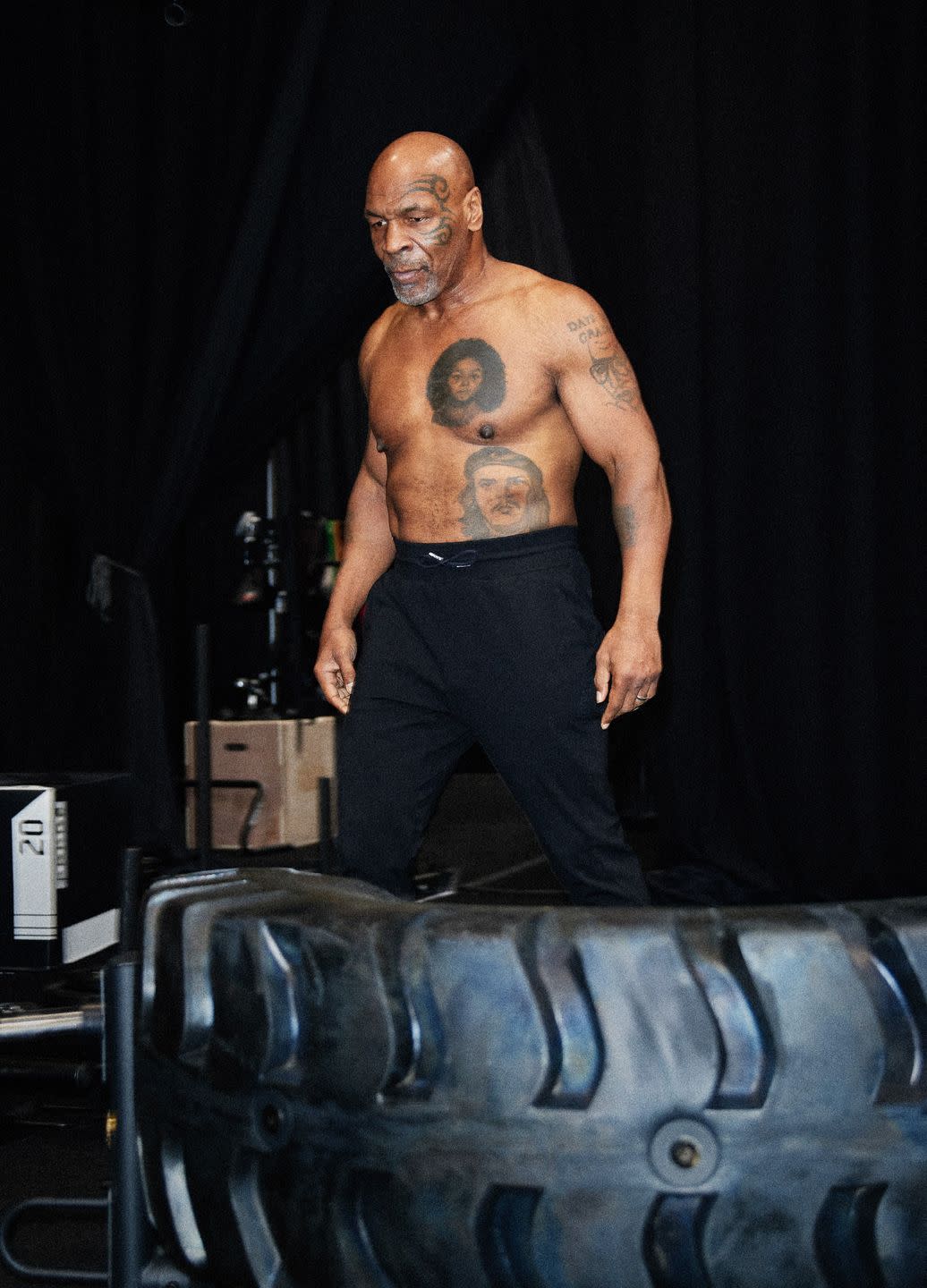
The age difference between the two is an inescapable, circuslike element in how the fight has been promoted and covered. The thirty-one-year age gap between Tyson and Paul is reminiscent of the multi-decade age gap presented in a fictional fight in the 2006 film Rocky Balboa. The difference is also greater than that in another major fight in Tyson’s career, when, at twenty-one, he decimated thirty-eight-year-old Larry Holmes with a fourth-round knockout. Tyson takes a breath before considering any parallels between this fight and the one from 1988. He is unbothered being on the other side of a younger challenger. Tyson, who is a summa cum laude scholar when it comes to the history of boxing, notes one “big fundamental difference” between the bouts. There are levels to these mind games, and no one has weaponized the word YouTuber quite like him.
“Larry Holmes was a legendary fighter who was fighting a champion who was active every day of his life,” Tyson says before his workout. “I am fighting a YouTuber.”
He adds of Paul, “It doesn’t matter how seriously he’s taking it. He is who he is.”
Tyson’s publicist, Joann Mignano, echoes her boss’s confidence: “We’re used to the doubters; we’re used to the haters. I know the Vegas bets are all doubting Mike. But he’s ready for war.”
What started out as a joke to some turned into a legitimate fight after the Texas Department of Licensing and Regulation surprisingly sanctioned the match in late April. As part of the process, the agency required Tyson to take a physical, an eye exam, and a blood test, as well as EKG and EEG tests, spokesperson Tela Goodwin Mange says. The nineteen years between Tyson’s last sanctioned fight—a 2005 loss to Kevin McBride—and the upcoming one with Paul was considered “but was not a factor.”
That hasn’t stopped many from wondering why the fight is sanctioned and whether anyone cares about Tyson’s well-being. Promoter Oscar De La Hoya, a former world champion in multiple weight classes, urged Tyson to be careful and said he was going to pray for him in what he described as “a dangerous fight.”
Deontay Wilder, another former world heavyweight champion—whose career has been trending down recently—questioned whether enough people give a damn about Tyson potentially getting injured. He said that Tyson was “too old for this.”
When I ask Tyson about Wilder’s comments, he’s initially calm about the concerns his peers have about him being seriously hurt: “Then let Mike get hurt. You don’t have to worry about paying my bills.” As he thinks about it more on the black-leather couch at his gym, he has more to say.
“Everyone says this makes no sense, but he’s how old?” asks Tyson about the thirty-eight-year-old Wilder. The younger heavyweight, says Tyson, shouldn’t feel sorry for him and doesn’t know him or understand him. “He’s not who I am. He can’t go to Mongolia and have somebody know who the fuck he is.”
In a brief statement, sent a couple of days before Wilder lost his most recent fight by knockout to the Chinese heavyweight Zhilei Zhang in early June, Wilder says he “would just like to wish Mike the best.”
Surrender was never in Tyson’s vocabulary. The word was not in the lexicon of Alexander the Great, one of Tyson’s heroes, so why should it have been in his? Still, he had to learn it, and quickly, if he wanted to save his family and maybe his life.
In his words, the journey to selflessness began a little more than a decade ago with the release of his memoir, Undisputed Truth. The cover photo of the book, showing an almost broken Tyson with some stubble, is described by the fighter as a reluctance to surrender. That period meant not just surrendering to God but also having to hear from Kiki and his family about the hell he had put them through to move forward.
“I don’t know if it feels good to surrender,” he says before his workout. “But it does feel good that it’s over—all the dark stuff is over.”
His light is Kiki, whom he has known since she was a teenager through her father’s connections in the boxing industry. They tried being with each other a couple different times, but it never worked out. At the time, she was too down-to-earth, and he was not on this planet. Her patience and discipline were what he needed. He just didn’t know it. They eventually figured it out and have been nearly inseparable since Tyson called her after he got out of rehab. They married in 2009 and have two children, Milan, fifteen, and Morocco, thirteen.
“He finally found the right person. Kiki is a wonderful wife, and boy, she’s the boss, too,” Flair says, laughing. “We all need that.”
Gary Smith, the former Sports Illustratedwriter who profiled Tyson in 1988, remembers how the odds back then were “monstrously low” for anything resembling the boxer’s life today.
“There was no way that this seemed like a sustainable operation,” Smith says. “Somehow, against every odd, it turned the other way. I don’t think you could have ever predicted this one at all. He may be the biggest proof that you just never know in life.”
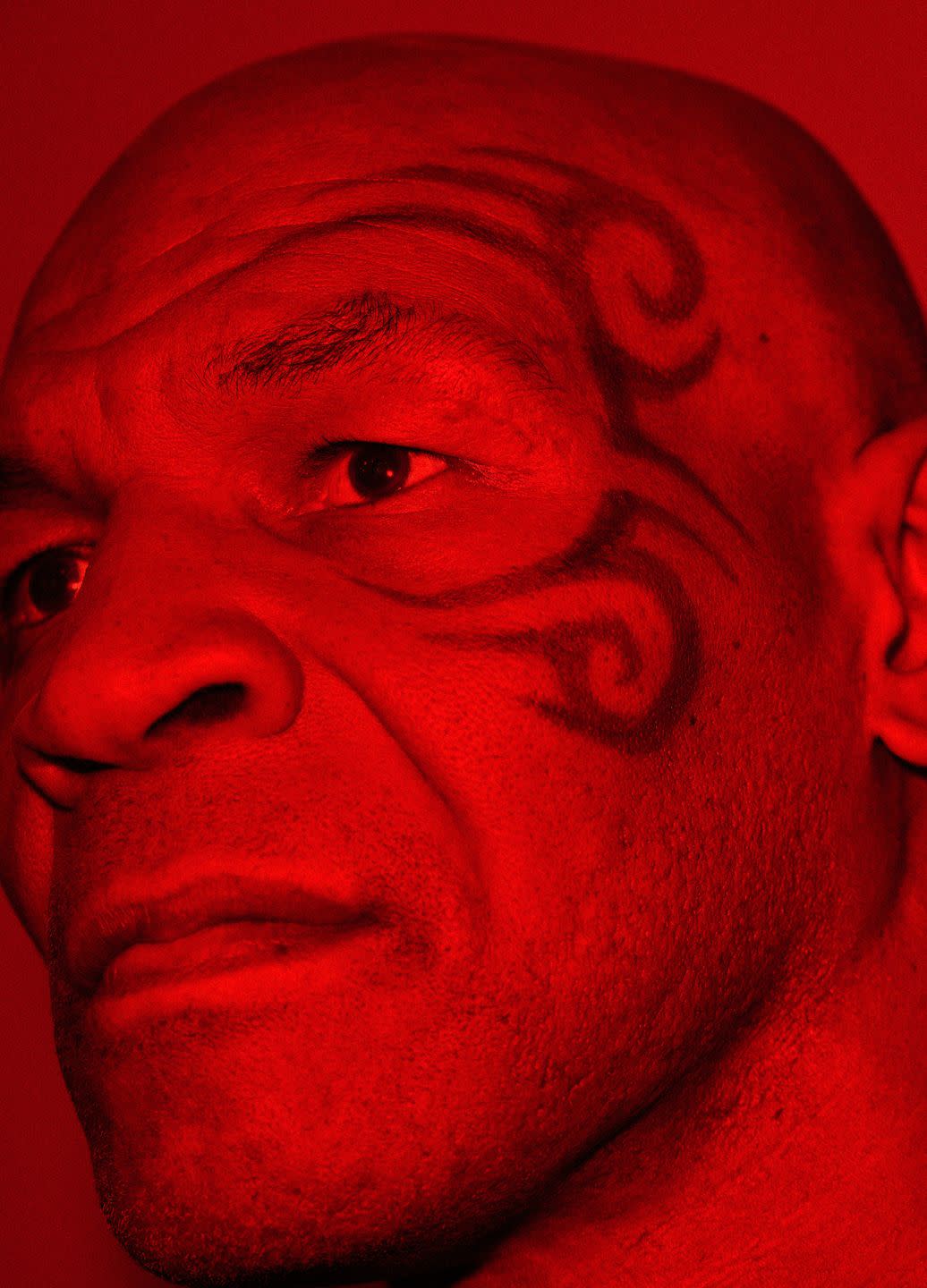
Tyson is proud as he talks about how his daughter is now the avid reader in the family, joking about how reading Machiavelli and Tolstoy will make her feel superior to other people just like he did. The bout with Paul will be the first time the children he has with Kiki will get to see a real fight of his, but he hasn’t thought about what that’ll mean to him. I ask him about the importance of Kiki in his life. For the first moment in our time together, Tyson is almost speechless, trying to find the right words: “No one would think I would be with a woman for the rest of my life. It was almost inconceivable that this happened.”
He then exclaims, proudly: “And she’s a genius! She created the ears!”
Tyson is referring to one of his cannabis company’s best-selling products: gummies shaped to look like the ear of Evander Holyfield, which Tyson infamously bit off part of during their 1997 fight. Tyson has turned what was a casual and therapeutic appreciation for cannabis into a big business at a time when legalization has swept across the United States. His Tyson 2.0–brand products are now being sold at 745-odd retailers. He’s parlayed his celebrity in the cannabis space into a popular podcast, Hotboxin’ with Mike Tyson, that recently wrapped up. He’s even taken on advocacy. Earlier this year, Tyson called on President Biden to grant clemency for all federal marijuana offenders.
“It’s a plant that makes you happy and hungry,” he says, admitting that it’s hard to give up and that he was not his best self around his family in the first week of training for the fight when he stopped using. “The family wasn’t friendly with me. I did not behave well.”
Before cannabis was Tyson’s therapy, there were the pigeons. So many pigeons. Adam Wilks never thought much of pigeons until he got to know Tyson as the CEO of Carma HoldCo, the parent company of the Tyson 2.0 cannabis brand. That started to change when the two were in Amsterdam for an event last September and Tyson asked Wilks if he wanted to drive a few hours north to meet a breeder of roller pigeons. Wilks agreed, not knowing what to expect or how long they’d be there.
Want more great stories like this?
Subscribe to Esquire
“Everybody goes up to Mike and their jaw drops,” Wilks says. “I had never seen the opposite where Mike meets someone and he’s excited about it.”
They stayed until 1:00 or 2:00 in the morning, Wilks says, with Tyson looking starstruck. The family and Wilks had to go to bed, but there was Tyson, in the freezing cold, hanging with the pigeon breeder and playing in the coop with the birds in the early-morning hours somewhere in the Netherlands.
And Tyson couldn’t have been happier.
Back in the ring at training camp, Tyson repeatedly lands lefts and rights on a padded-up Cordeiro until he gets his footwork the way he wants it. The former champ keeps telling Cordeiro, White, and Mike Angel, his videographer, who films everything, how much better he feels.
“It’s beautiful form,” Cordeiro says in his Brazilian accent, looking giddy.
Tyson recently got over a respiratory cold that he couldn’t kick when he was in New York to promote the fight.
“I’m happy to be back,” Tyson repeatedly says, feeling himself again. “I was fucked up in New York.”
The fire that burns inside is blue, but Tyson is turning it up to hype himself up.
“He’s not going to hit me with the jab,” he promises of his fight with Paul.
White goes one step further to hype up his fighter: “He’s not going to land a blow on you.”
Tyson takes another swig of electrolytes and then looks in my direction. He rarely lets people watch him train who aren’t in his inner circle.
“I thought I was gonna embarrass myself in front of you today,” he tells me, relieved that he looked like a contender instead of a tomato can.
There are two things Tyson told me he is planning to do, before and after what might be his final fight. First, days before the bout, he will ingest a drug derived from the poison of the Sonoran Desert toad—known as 5-MeO-DMT or simply “the Toad”—for what he calls a one-way trip to meet God. He’s done the psychedelic close to a hundred times now, but he doesn’t know what he’ll talk to God about this time. He only knows it’ll be deep.
“I meet God every day when I look in the mirror,” he says. “Aren’t we images of him? That’s what they say in the Bible. So I guess I meet him every time I look in the mirror.”
The second item on his agenda will come after the fight. Whether it ends up being his fifty-first win or his seventh loss, Tyson will take some time to himself in his locker room at the football stadium. He’ll lean back in his chair and take that moment alone to hear his heartbeat. Only in that moment will Tyson, who was taught most of his life to believe that he was a god, know that he’s still fully alive. Even if the destroyer is no longer there.
“I’m fifty-eight years old, and I’m gonna sell out an eighty-thousand-seat arena,” Tyson tells me. “Hey, if that’s not godlike, I don’t know what is.”
For Tyson, it’s one more shot at immortality.
You Might Also Like
